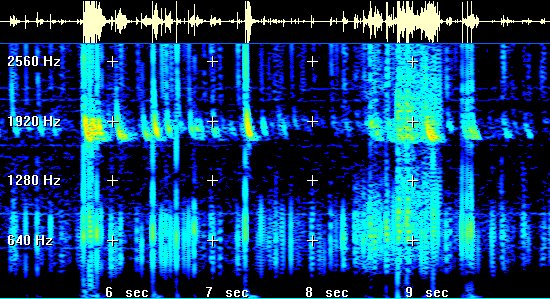Lightning and thunder (and tweeks, sferics, and whistlers)
 The sound that comes from lightning sounds the way it does – a crack followed by a rumble – because the high frequency sounds from the explosion travel more quickly through the atmosphere than the lower frequency sounds. This is called “dispersion” ((http://www.physics.uoguelph.ca/summer/scor/articles/scor163.htm — best link if you’re just going to read one of these)). It’s the same phenomenon that you see in optics when light gets split through a prism.
The sound that comes from lightning sounds the way it does – a crack followed by a rumble – because the high frequency sounds from the explosion travel more quickly through the atmosphere than the lower frequency sounds. This is called “dispersion” ((http://www.physics.uoguelph.ca/summer/scor/articles/scor163.htm — best link if you’re just going to read one of these)). It’s the same phenomenon that you see in optics when light gets split through a prism.
The farther you are from the lightning, the more low frequency sound you will hear in the thunder ((http://www.madsci.org/posts/archives/nov99/943317470.Ph.r.html)). This is due to both dispersion, which attenuates the high frequencies more ((http://www.physics.uoguelph.ca/summer/scor/articles/scor163.htm)), and diffraction, which helps low frequency sounds “bend around” obstacles better than high frequency sounds ((http://hyperphysics.phy-astr.gsu.edu/hbase/sound/diffrac.html)), so they can travel farther.
Radio waves are affected by dispersion as well. While reading about lightning and thunder, I stumbled across this amazing thing: very low frequency (VLF) radio receivers for the Earth’s natural radio emissions. The sound samples on this page are really cool.
This is crazy stuff. You can listen to a live VLF audio stream through the NASA online VLF receiver.

2 Comments
- Brian Anderson replied:
Why would there be dispersion of the low and high frequency sounds of thunder? Unless the sounds are of very large amplitude, there is no dispersion of sound waves in air. If there were, a rock concert would sound quite strange in the back row, since the 6 string guitar sounds would reach your ears before the bass guitar sounds. Instead of dispersion, my guess is that the low frequencies (that travel father than high frequencies) reflect off of far away boundaries and then reach your ear. So you hear the initial crackle which includes all frequencies and then you hear the reflections of the low frequencies from mountains, etc.
October 5th, 2007 at 12:51 pm. Permalink.
- Radiolariax replied:
Interesting site:
Signal and wave hunting
http://www.freewebs.com/radiolariax
The hunt for weird radio signals and other electromagnetic waves with small, cheap modified radios, cassette players, walkie-talkies, mp3 players,
dictaphones, babyphones, pc speakers, vacuum cleaners and particle accelerators.June 25th, 2009 at 3:54 am. Permalink.